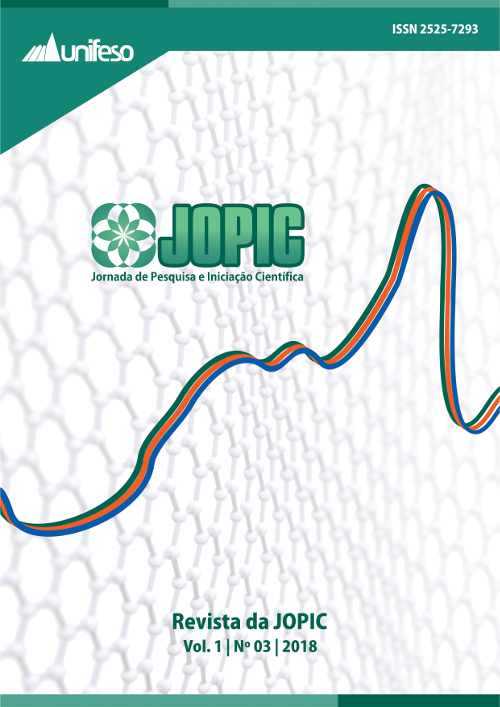DOCKING MOLECULAR E TOXICOLOGIA IN SILICO DE NOVAS SÉRIES DE CANDIDATOS A INIBIDORES DA ENZIMA FAAH1
Palavras-chave:
Endocanabinóide, Inibidores da FAAH1, Otimização Estrutural.Resumo
Neste novo estudo os resultados de docking molecular mostram que as novas séries (2, 3 e 4) de inibidores da enzima FAA1 apresentam energias de ligação global na ordem de 5.5 – 10.2 (Kcal/mol). O risco toxicológico é baixo e os valores das propriedades físico-químicas como drug-likeness e drug-score qualificam as séries a candidatos a ensaios in vitro e in vivo.
Referências
AGARWAL, N. et al. Cannabinoids mediate analgesia largely via peripheral type 1 cannabinoid receptors in nociceptors. Nat. Neurosci. 10, 870-878, 2007.
CARLSON, H. A. et al. Differences between high-and low-affinity complexes of enzymes and nonenzymes. Journal of medicinal chemistry, 51(20), 6432-6441. 2008.
CRAWLEY, J. N. et al. Anandamide, an Endogenous Ligand of the Cannabinoid Receptor, Induces Hypomotility and Hypothermia in-Vivo in Rodents. Pharmacology Biochemistry and Behavior. 46. 4, 967-972. 1993.
DI MARZO, V.; PETROSINO, S. Endocannabinoids and the regulation of their levels in health and disease. Curr. Opin. Lipidol. 18, 129-140, 2007.
DODD, G. T. et al. The peptide hemopressin acts through CB1 cannabinoid receptors to reduce food intake in rats and mice. J. Neurosci. 30, 7369-7376, 2010.
FREUND, T. F.; KATONA, I.; PIOMELLI, D. Role of endogenous cannabinoids in synaptic signaling. Physiol. Rev. 83, 1017-1066, 2003.
HOWLETT, A. C. et al. Classification of cannabinoid receptors. Pharmacol. Rev. 54, 161-202, 2002.
LIPINSKI, C. A. Lead- and drug-like compounds: the rule-of-five revolution. Drug Discovery Today: Technologies. 1, 4. 337-341. 2004.
MORRIS, G. M. et al. AutoDock4 and AutoDockTools4: Automated docking with selective receptor flexibility. Journal Computational Chemistry. 30, 16. 2785-2791. 2009.
NOONAN, J. et al. Endocannabinoids prevent beta-amyloid-mediated lysosomal destabilization in cultured neurons. J. Biol. Chem. 49, 38543-38554, 2010.
ORGANIC CHEMISTRY PORTAL. 2015. Available at http://www.organic-chemistry.org/prog/peo/. Accessado em 22 de setembro de 2015.
PERTWEE, R. G. Cannabinoid receptors and pain. Prog. Neurobiol. 63, 569-611, 2001.
PERTWEE, R. G. Elevating endocannabinoid levels: pharmacological strategies and potential therapeutic applications. Proceedings of the Nutrition Society. 73, 96–105. 2014.
PERTWEE, R. G. et al. Cannabinoid receptors and their ligands: beyond CB1 and CB2. Pharmacol. Rev. 62, 588-631, 2010.
RAIES, A. B.; BAJIC, V. B. In silico toxicology: computational methods for the prediction of chemical toxicity WIREs Comput Mol Sci, 6:147–172, 2016.
SAITO, V. M.; WOTJAK, C. T.; MOREIRA, F. A. Exploração farmacológica do sistema endocanabinoide: novas perspectivas para o tratamento de transtornos de ansiedade e depressão? Rev. Bras. Psiquiatr. vol.32 supl.1 São Paulo May 2010, S7-S14.
SHOHAMI, E. et al. Endocannabinoids and traumatic brain injury. Br. J. Pharmacol. 163, 1402-1410, 2011.
TAVARES, L. C. QSAR: a abordagem de Hansch. Química Nova, 27(4), 631-639. 2004.
TROTT, O. e OLSON, A. J. AutoDock Vina: improving the speed and accuracy of docking with a new scoring function, efficient optimization, and multithreading. Journal Computational Chemistry. 31, 2. 455-61. 2010.
Downloads
Publicado
Edição
Seção
Licença
Os textos são de exclusiva responsabilidade de seus autores.
É permitida a reprodução total ou parcial dos artigos da Revista da JOPIC, desde que citada a fonte.
Este trabalho está licenciado sob uma Licença Creative Commons 3.0: http://creativecommons.org/licenses/by/3.0/


